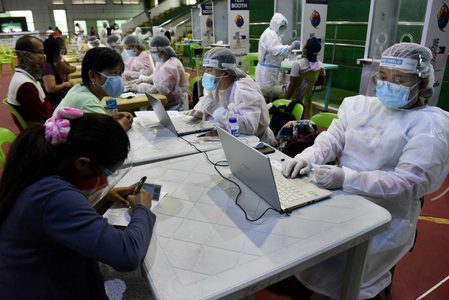SUMMARY
This is AI generated summarization, which may have errors. For context, always refer to the full article.

President Rodrigo Duterte announced on Monday night, August 31, that Metro Manila will remain under general community quarantine (GCQ) until September 30.
Meanwhile, Iligan City, where cases are rising, will be reverted to a stricter modified enhanced community quarantine (MECQ) starting September 1.
Aside from Metro Manila – the epicenter of the pandemic in the Philippines – Bulacan and Batangas will also remain under GCQ. Tacloban City and Bacolod City will be reverted back to GCQ from modified GCQ.
The rest of the country will be under modified GCQ, the most relaxed form of community quarantine.
Duterte’s decision comes after the country saw a surge in new coronavirus cases from mid-July to August.
Researchers studying the pandemic in the country observed that cases are still increasing in the country, though at an average of some 3,721 cases per day from August 23 to 29 – lower than the 4,000 new cases reported daily from August 2 to 22.
As of Monday, the Philippines counted over 220,000 confirmed cases, including 3,558 deaths.
What to expect
Starting September 1, the community quarantine levels across the country will last for a month, instead of just two weeks. Trade Secretary Ramon Lopez earlier said the government’s coronavirus task force sought to provide stability to business operations with longer quarantine periods.
The GCQ that will be implemented starting September will be less strict than the GCQ implemented from August 19 to 31.
Earlier on Monday, Lopez said non-contact gyms, drive-in cinemas, internet cafes, as well as personal grooming services will once again be allowed to operate in areas under GCQ starting September 1. Aside from this, pet grooming services as well as review centers will also be allowed to reopen.
Government officials earlier wanted to reopen gyms and other types of establishments on August 1, but the move was met with opposition from doctors who appealed for a review of the measure.
Lopez said that for gyms and internet cafes, the trade department will craft specific guidelines with Metro Manila local governments to determine the extent of operations that will be allowed, along with specific health requirements that should be in place.
Experts earlier urged caution over reopening these locations as they are known to carry high risks of transmission. Because they operate in confined settings with limited airflow, studies have pointed out these locations make it difficult for droplets carrying the virus to properly disperse, unlike in open spaces.
Other sectors like drive-in cinemas and personal grooming services will be allowed to operate at 30% capacity.
Minimum health standards such as wearing face masks and face shields, practicing physical distancing, and promoting frequent handwashing remain in place under all levels of community quarantine.
Suppressing infections
According to health experts, it is crucial to suppress transmissions in Metro Manila and nearby provinces such as those in Calabarzon.
Metro Manila alone accounts for about 55% of nationwide cases. Experts earlier pointed out that “many if not most of the COVID-19 cases in the provinces were imported from the nation’s capital.”
Experts also urged the government to exercise vigilance and closely monitor 6 areas of “urgent concern,” namely Bacolod City, Iloilo City, Iligan City, Davao del Sur, Leyte province, and Zamboanga City.
They were classified as “areas of urgent concern” as data showed health services in these areas were either overwhelmed with patients or risked being overburdened from growing infections and a limited number of hospitals that can cater to the sick.
Experts initially called for Bacolod City to be placed under MECQ, as the city’s total COVID-19 dedicated bed occupancy was already at 72% as of Friday, August 28 – breaching the 70% “danger threshold” set by the Department of Health. Just two weeks ago, only 59% of the city’s total COVID-19 beds were occupied.
Duterte, however, placed Bacolod City under GCQ. – Rappler.com
Add a comment
How does this make you feel?

There are no comments yet. Add your comment to start the conversation.